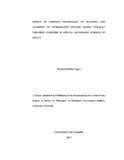| dc.description.abstract | The study aimed at investigating effect of assistive technology on teaching and
learning of integrated English among visually impaired learners in special
secondary schools in Kenya. The objectives of the study were to determine the
extent to which compatibility,trialability,observability, complexity and relative
advantage of Assistive Technology affects teaching and learning of integrated
English among visually impaired learners in special secondary schools in
Kenya. The research design was descriptive research design. The target
population was 4 principals, 48 teachers and 480 students.The sampling
techniques were simple random sampling and purposive sampling.The sample
size was 4 principals, 48 teachers and 218 students, yielding sample size of
270. The data was collected using questionnaires, observation schedule and
focus group interviews. The data was analyzed quantitatively using Statistical
Package for Social Sciences and qualitatively using content analysis.
Compatibility of an Assistive Technology significantly affects teaching and
learning of integrated English among visually impaired users. In the second
objective, results indicated that complexity of AT significantly affect teaching
and learning of visually impaired learners.The trialability of AT statistically
significantly affects teaching and learningof visually impaired learners.In
objective four, observability does not statistically significantly affect teaching
and learning of visually impaired.The relative advantage of Assistive
Technology does statistically significant affect teaching and learning of
integrated English among the visually impaired.The Observability of AT does
not affect teaching and learning of visually impaired learners but
compatibility, complexity, trialability and relative advantage affects teaching
and learning of visually impaired learners.The management should make an
assessment of how compatible an AT device.They should carefully consider
how easy to use or understand AT before adoption. The management should
test AT before they are used by learners. They should consider observability
but not as much as the other variables. It would be important for management
to consider whether an AT would be value to the users before they are
purchased by the school.Therefore to enhance teaching and learning of
visually impaired, it is important for school management liaising with
Ministry of Education and other stakeholders such Sights Savers, Kenya
Institute of Special Education to consider compatibility, trialability,
complexity and relative advantage of Assistive Technology. | en_US |

